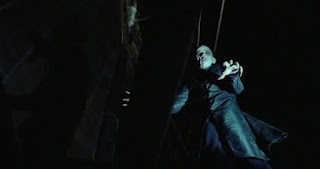#11 (tie) - 11 votes
Before the month is over, I wanted to share this contribution from Vanessa Vinci on Lucio Fulci's Zombi 2 (aka Zombie). Thanks, Vanessa!
Lucio Fulci’s Zombi 2 (aka Zombie, aka Zombie Flesh Eaters) is probably the most obscure late 70s Italian gorefest that everyone’s heard of and generates some fantastic Abbott and Costello-style descriptions of the movie itself:
“If I haven’t seen Zombi 1 or 2, can I watch Zombi 3?”
“Zombi 2 is the first one, there is no Zombi 1.”
“So Zombi 3 is Zombi 2?”
“Zombi 2 is Zombi 2.”
“Then what’s Zombi 1?”
“Dawn of the Dead.”
“Then what’s Zombi 1?”
“Dawn of the Dead.”
Thanks to Italian copyright law, Lucio Fulci’s Zombie, the first in the Zombie Flesh Eaters series, borrowed the popularity of Romero’s cynical allegory and used it to return audiences to the voodoo-inspired roots of White Zombie or I Walked With a Zombie. After the chilling opening scene where a seemingly abandoned sailboat drifts into the Hudson (as perfect a horror opener as ever was and used in everything from Dracula to The Strain), the action shifts to the mysterious island where interloping doctors have been tampering with local superstition to find a scientific explanation for zombie-ism. Here, though, there is no witch doctor, no grand evil mastermind puppeteering the undead for a greater scheme; the dead are rising and both science and magic are equally useless at explaining or controlling the devastation.
Plot, acting, characterization and dialog aren’t the movies strong points. The characters are the kind of stock horror movie folk where the men stick around places that are clearly unsafe far longer than self-preservation would dictate while the women are prone to things like topless scuba-diving in shark ridden waters. The zombies don’t move very fast, but with this crowd they don’t have to.
Fulci keeps the stripped down storyline of Romero’s Dead movies but without the better actors. What he does use well is atmosphere: like Night of the Living Dead’s secluded farmhouse and Dawn’s shopping mall, Zombie combines the sweltering tropical setting with the relentless drumming score to create a world where everything feels fetid. When his zombies start rising en masse from a cemetery with their worm-ridden orifices it makes total disgusting sense because of course anything buried in the dense island loam would show the worst kind of putrefaction.
In today’s zombie-saturated pop culture Zombie still deserves credit for one of the most beautiful sequences in a zombie film and one of the most brutal. Eyeball torture is a universal fear and, unlike any comparable scene in a torture-porn flick, desensitization never enters the equation. Even Un Chien Andalou doesn’t have those squishy sound effects to amp up the experience. And that zombie vs. shark sequence. What an awesome, almost balletic interaction between two apex predators, neither of whom knows what to make of the other or even how to experience the other except by taking a big ole’ bite out of it. The scene is colorful, eerie and totally mesmerizing, like the all the best moments of the film.
U.S. Release Date: July 18, 1980 (Also released that week: Cheech and Chong's Next Movie, Honeysuckle Rose, The Little Dragons)



















































